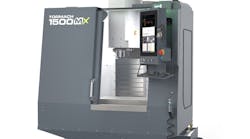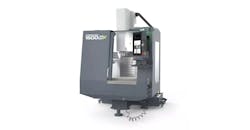There will be lots of new manufacturing technologies unveiled this year, particularly at IMTS 2024 in September. But the machine-tool enthusiasts at Tormach Inc. are well ahead of the crowd, recently revealing a new, three-axis machine and calling it “the apex of (its) engineering prowess.”
Tormach CEO Daniel Rogge backed up that claim in an interview about the new 1500MX, detailing how the machine-building business established just over 20 years ago arrived at this milestone in its progress. The company has always served the interests and means of individual machinists and hobbyists, along with classrooms, workshops, maker-spaces, and small businesses, to give those operators “easier, more accessible” ways to pursue their work and ideas.
The new Tormach 1500MX machine projects all the dedication embodied by those customers into a model that’s right for the market and the moment of 2024. It updates the Tormach standard to meet the evolved requirements of those targeted users.
The 1500MX is a servo-driven mill positioned on linear rails with an epoxy-granite frame that combines professional-grade capabilities with ease-of-use and compact versatility. In operation, Tormach reported, the new machine offers faster feed rates, increased precision, superior vibration damping, and higher horsepower than alternative machine options, but at a more buyer-friendly cost.
As for its performance, the 1500MX promotes the present-day expectations for machining efficiency and precision. That epoxy-granite frame offers ten times the damping of cast iron, according to Tormach, for chatter-free cutting, improved surface finishes, and 30% longer tool life.
The new machine includes a 4-HP, 10,000-RPM BT30 spindle (maximum 6HP), providing sufficient torque to cut through various materials and enough spindle speed to handle today’s carbide tooling.
With servo motors and absolute encoders offering 23-bit accuracy and battery backup, the 1500MX mill overcomes the need for machine referencing and delivers precision results even between power cycles. Cutting feed rates of up to 1,200 IPM (XY) reduce cycle times and take advantage of adaptive tool paths.
“We are most excited about the speed, power, and automation the 1500MX brings to both our prototyping and production abilities,” said beta-test customer Keegan Karl, vice president of DarkAero Inc., a manufacturer of high-performance composite aircraft components. “It is exciting to see how quickly it can create the parts we designed, and it feels powerful to simply send the program to the machine, press start, and watch it produce what we need autonomously.”
Making the switch
A new milling machine is not a spur-of-the-moment development. Rogge recalled that the 1500MX was developed as Tormach reconsidered the costs involved with the contract manufacturing model that it had always relied on to source components and construction for its machines. Affordability was (and is still) a foundational part of Tormach’s proposition, and the global manufacturing supply chain made it possible to select Asian machine builders to execute Tormach’s designs, so it could deliver reliable CNC machines to its customers.
By 2018, the onset of import tariffs precipitated a supply-chain problem that grew more dire with the global pandemic of 2020.
Cost was not the only factor that set Tormach on a new approach. Rogge explained that the business wanted to exercise more control over the execution of its machine designs and production quality, as well as better cooperation with its contract manufacturers. Thanks to a design project that began in 2021, and the effort to locate and commission regional suppliers and fabricators, the 1500MX that Tormach makes available now is its first machine assembled in North America. The machine’s frame and most structural components are sourced from U.S. suppliers, and the assembly is completed by a subsidiary business Tormach has now in Mexico.
Today’s developments
The new machine adopts numerous advanced functions that have emerged as standard in CNC operations over the past decade, such as thru-spindle coolant (TSC), a mist collector, and chip evacuation. The 1500MX also has a 16-tool changing device to support the high-power spindle.
Automation has become more standard for machining operations too, and the 1500MX is optimized to pair with Tormach’s ZA6 industrial robot.
And the machine is designed with a built-in camera for real-time monitoring, error-messaging capability, and numerous upgrade options that users may select according to their specific circumstances.
Of course, the developer’s emphasis on milling speed and precision with the 1500MX is in line with the overall standards of manufacturing today. Rogge added, however, that these details do not change the affordability of Tormach’s new machine. And, because the 1500MX is locally sourced and produced, operators will have better access to customer service and tech support.
As before, all the programming for the 1500MX is provided by Tormach’s free and open-source PathPilot® software.
And as Tormach solidifies its shift to local sourcing and production, Rogge indicated the business may follow the 1500MX with updates to earlier machine models, or even new machine types.
Above all the mission for Tormach remains on target – to supply those operations that especially rely on the ability and understanding of the machinist. As Rogge emphasized, 60% of Tormach’s revenue is drawn from small shops (two to three employees), as well as testing and prototyping businesses.
“Engineers do better work when they develop their own parts,” he said, saluting the skills and insight of Tormach machine operators. Those are the types of users whose input contributed to the design and development of the 1500MX, and who will gain the most from its arrival.
About the Author
Robert Brooks
Content Director
Robert Brooks has been a business-to-business reporter, writer, editor, and columnist for more than 20 years, specializing in the primary metal and basic manufacturing industries.


